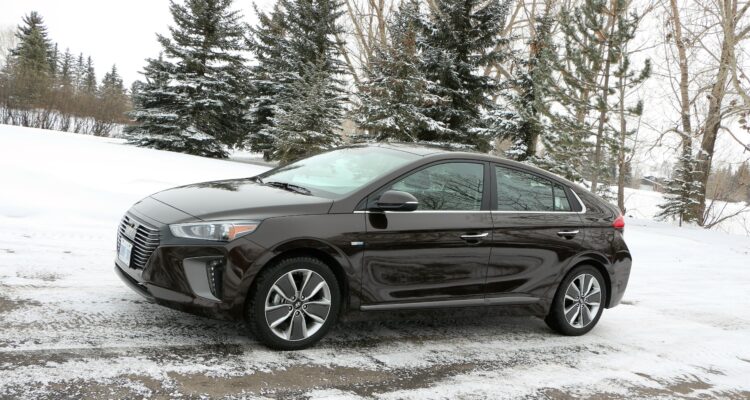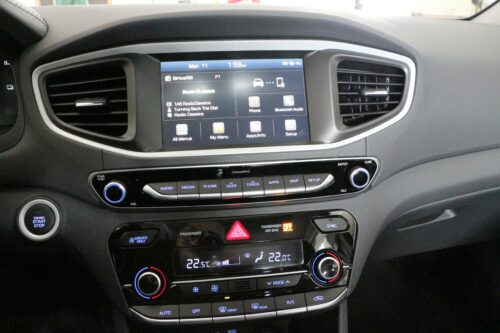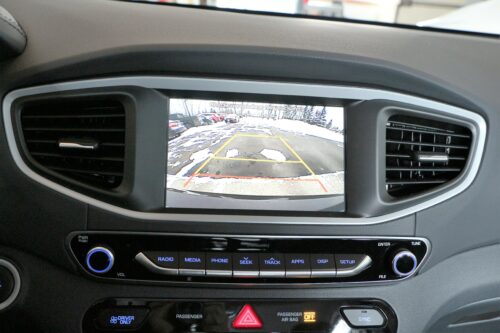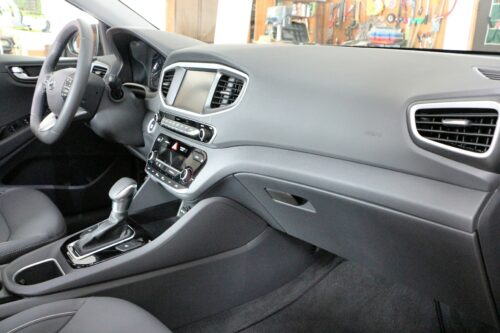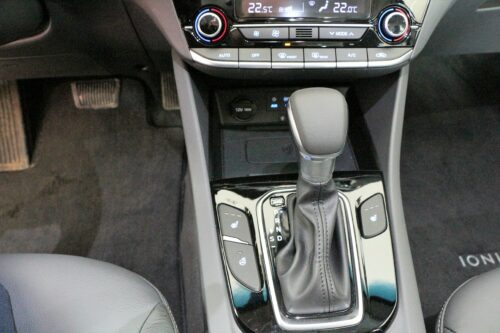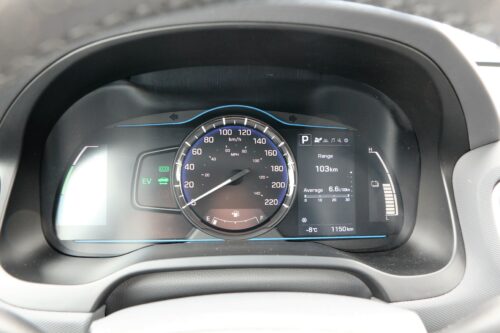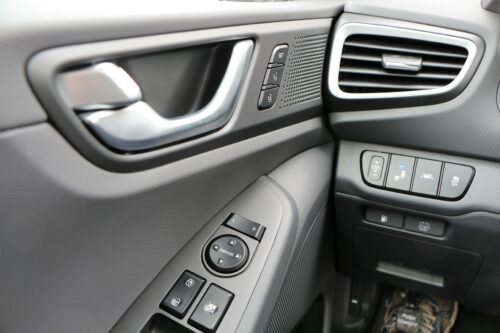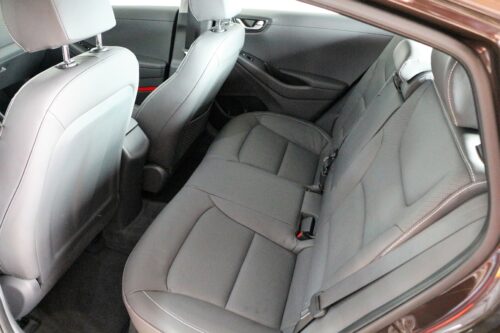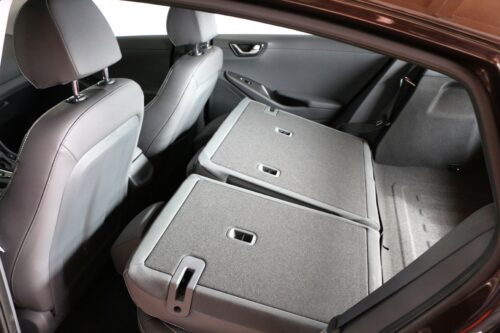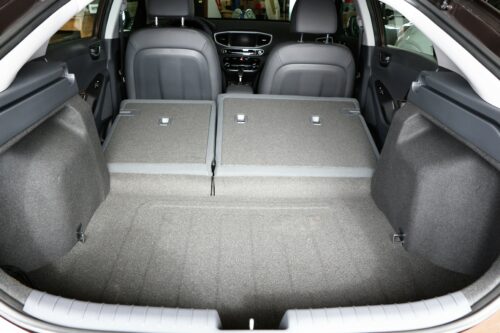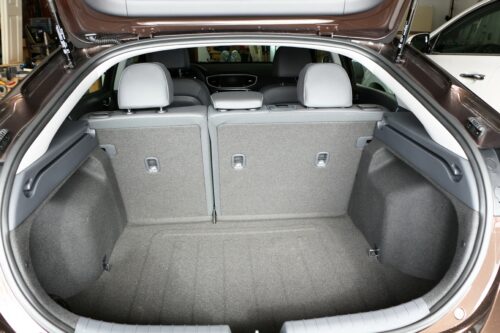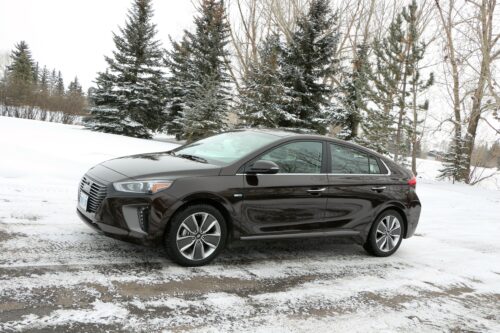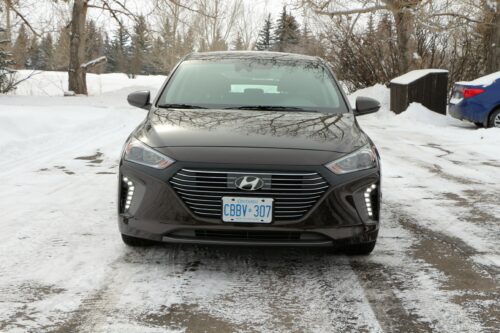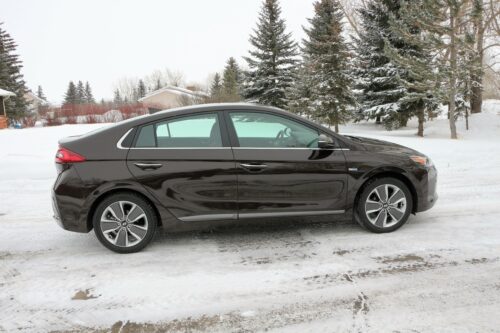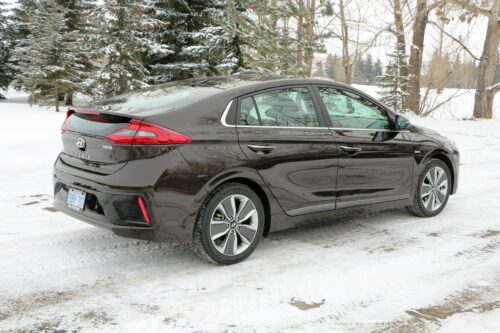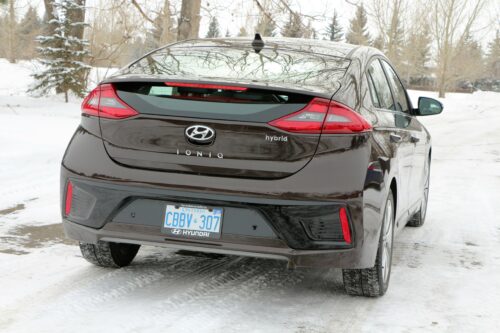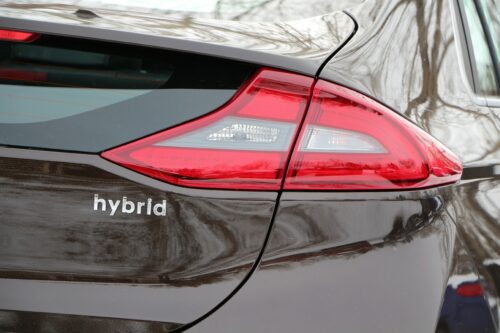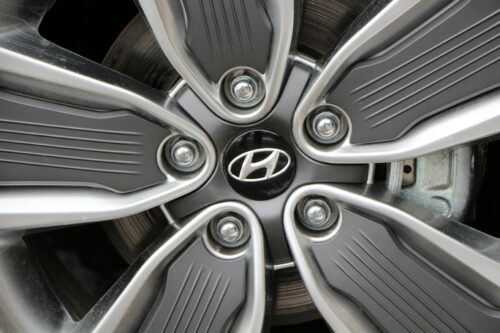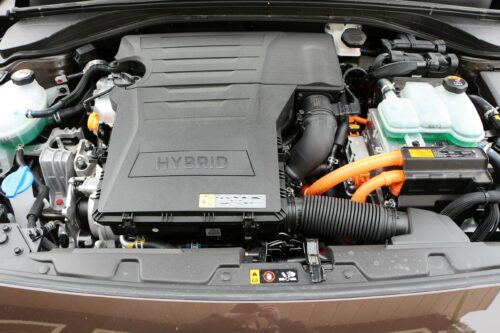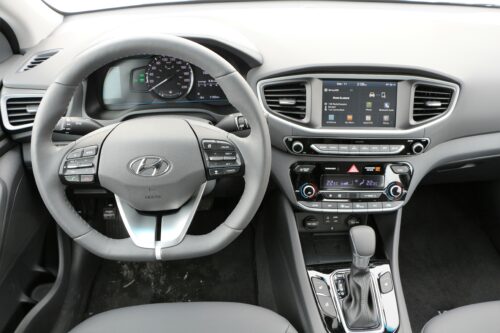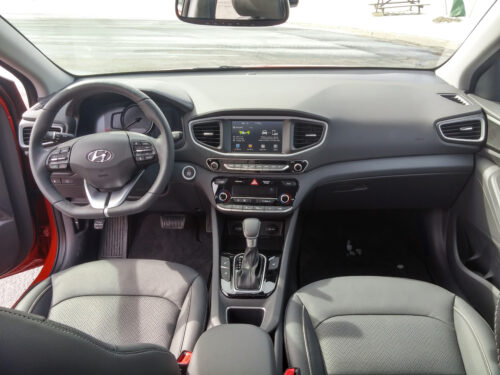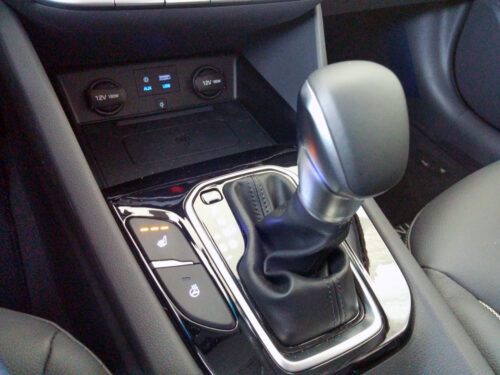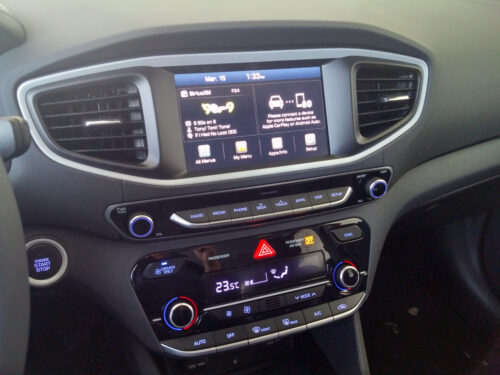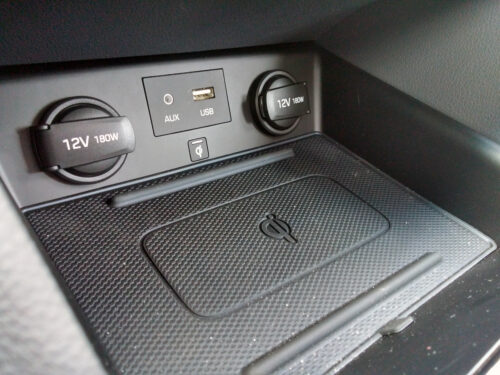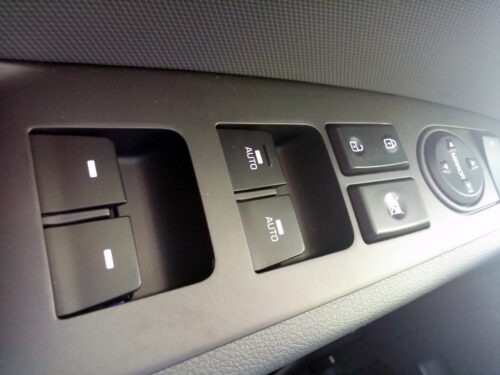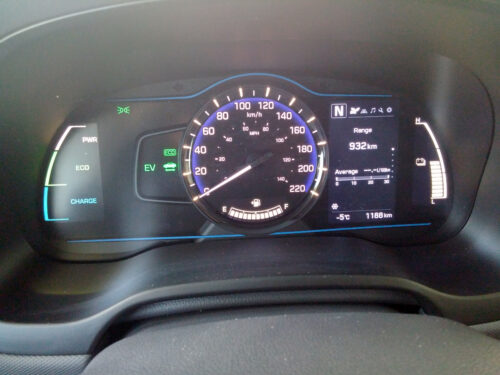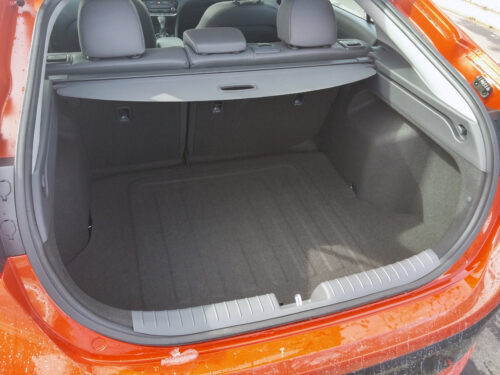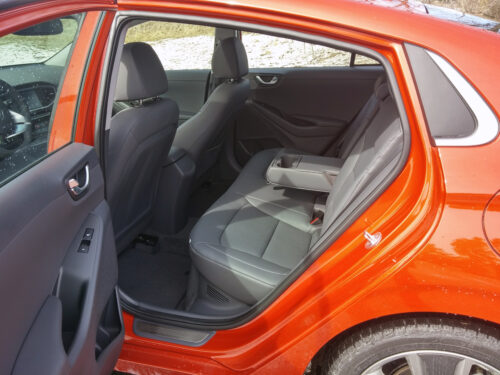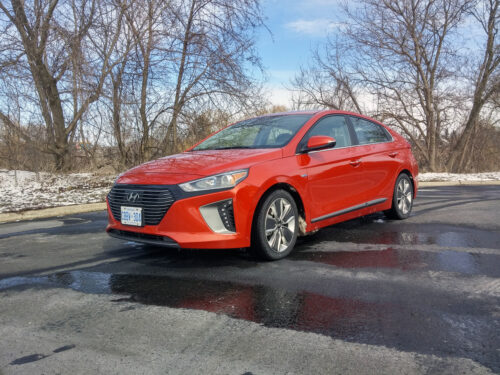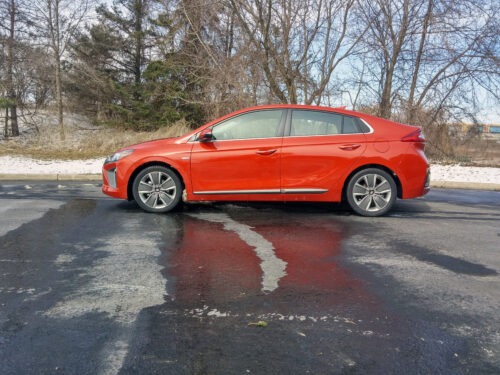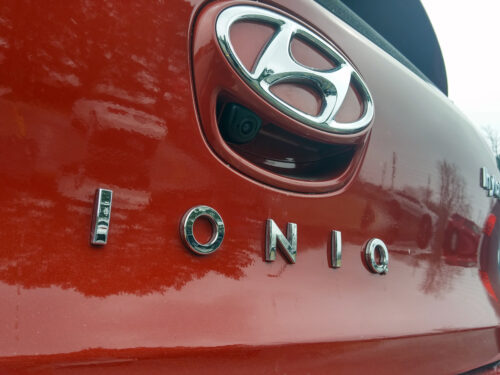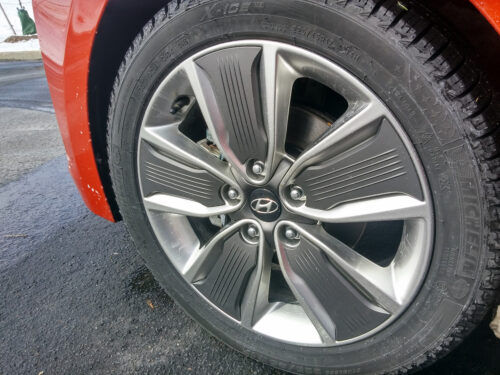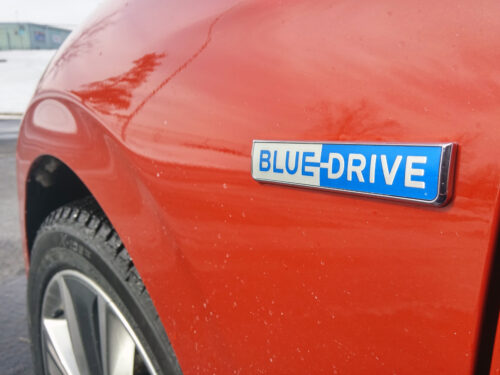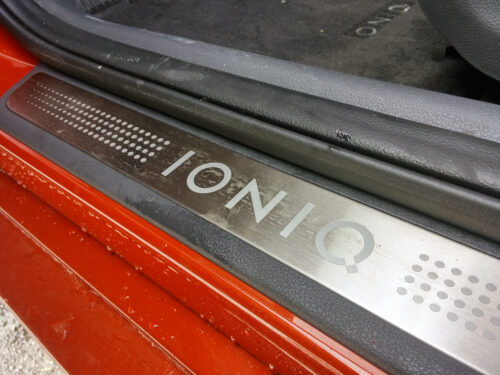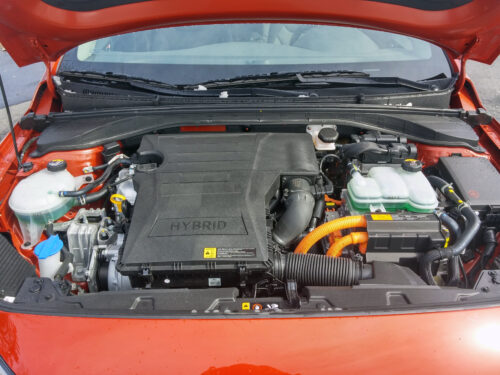Take one : Harry Pegg
Isn’t it Ioniq (ironic) that something so brown can be so green?
The 2017 Ioniq Hybrid test vehicle that arrived from Hyundai Canada all dressed up in a brown coat is definitely green no matter what its colour. This is the world’s first vehicle to come only with electrified powertrains: hybrid, plug-in hybrid and pure electric.
It’s not just powertrain that makes Ioniq green. New, recycled or eco-friendly materials make their first appearance in the Hyundai lineup to cut dependence on oil-based products. Interior door covers are made of natural plastic combined with powdered wood and volcanic stone. Materials extracted from sugar cane are part of the headliner and carpet, improving air quality and recyclability. Paint with renewable ingredients extracted from soybean oil is used to give some components a metallic look.
To avoid energy waste, the car’s climate control can be switched to an efficient operation mode that maximizes the use of cabin air when air-conditioning or heating are activated. Additionally, the dual-zone climate control can be set to a “driver only” mode to reduce the load of the air-conditioning and heating.
Hyundai is one of the few automakers offering brown vehicles and it suits the sleek shape of the hatchback design that turns heads without screaming “look at me.”
The exterior design with air flow channels integrated into the front LED position lights provides a drag coefficient of just 0.24 making it the slipperiest vehicle in its class.
Designers gave the interior a clutter-free and simplistic, ecologically friendly, if somewhat austere, appearance. However, they’ve supplied clear, easy-to-read instrumentation and put everything in the right place so it’s all quickly intuitive.
Information systems tell you everything you want, or need, to know about the car and its systems from power flow to temperature and anything in between. The displays are clear and information is easily access — and there are knobs for the audio system
The 7-inch LCD instrument cluster in ECO mode simulates a familiar speedometer needle. Select SPORT mode and it changes into a revolving digital speedometer surrounded by an analog-style tachometer showing engine speed on a red background.
Four of the five seating positions are comfortable and heated which emphasizes the fact that a five-passenger vehicle is really for four.
From the power-adjustable driver seat, visibility is good out front, but the outlook isn’t so clear looking rearward largely due to rear seat headrests. The vertical portion of the rear window design could use a method for cleaning because it’s one of the first areas to get mucked up when roads are sloppy.
Under the hood is a 104-horsepower 1.6L gasoline direct injected four-cylinder engine that’s linked to a class-exclusive dual clutch six-speed automatic transmission.
The hybrid’s 32-kW lithium-ion battery pushes the system output to 139 horsepower and torque to 195 lb. ft. from 109.
I’ve just spent a week in the 2017 Ioniq Hybrid and was overjoyed to find that the thing really does change gears through a dual clutch six-speed automatic transmission rather than the CVT found in other hybrids. That means no motorboat effect as the car accelerates. A good thing indeed.
My test period came during a cold snap that had brass monkeys worried: -20 °C or worse on five of the seven days which make me appreciate the heated steering wheel and seats.
Through it all, Ioniq performed very well although I suspect the cold had some effect on fuel efficiency. NRCan mileage figures are 4.3 L/100 km city, 4.4 highway, at the end of the week my average was 5.7.
Yes, part of it could be due to some enthusiastic driving and spending a good deal of time in SPORT mode. ECO is fine, but selecting the sportier mode brings a huge increase in fun factor.
The car won’t win many stoplight races, but the instant torque from the electric motor, provides enthusiastic performance.
I like that electric mode is available at just about any speed and the switch from electric to engine power is seamless.
Steering response is quick and provides excellent feedback. I’m able to find a couple of bendy ice-free roadways and even with winter tires on the 17-inch alloys, cornering is precise.
Of course there’s always a car full of electronic nannies on hand to make sure I stay safe. The test car has autonomous emergency braking with pedestrian detection, blind spot monitor, rear cross-traffic alert, lane change assist, lane departure warning and stability control to name a few. And there’s always the human in the right seat hollering “watch out” (needlessly).
I can’t find much to dislike about the Ioniq. There’s that rear visibility issue and the rear seats don’t fold completely flat, but given the fact the hybrid battery is located under the rear seat, I can’t really harp on that too much.
Take two : Sabrina Giacomini
My first thought looking at the Ioniq was “It looks good, but it also looks familiar”. True enough, I quickly noticed the design similarities with the new Hyundai Elantra, including the feline headlights and LED strips fog lights. At the back however, belonging to the Hyundai family is questionable. It does have a rear window similar to the Veloster’s, but the silhouette is reminiscent of a Chevrolet Volt, with the gentle slope of the roof plunging 90 degrees at the hatch, ending on a wide rear door. Not an unpleasing sight but one that definitely screams “hybrid”.
On the inside, the Ioniq has a lot to offer, like most Hyundai vehicles, though the recurring absence of a proper navigation system to instead favour the use of the Apple CarPlay or Android Auto, is a move by some automakers that is slightly annoying. This means your smartphone needs to be connected to the car’s infosystem at all times, as well as your data, which in my opinion is an issue when, like me, you don’t have an unlimited data plan. Rant over.
That being said, you can enjoy every feature Hyundai has to offer, including satellite radio, heated seats and steering wheel, cruise control, wireless charging, safety assists and such. And the interior design is modern, a little heavy when it comes to the centre cluster, but overall easy to use and nice to look at.
The Ioniq also offers good, useable interior space : legroom at the back is comfortable and the cargo volume is surprisingly generous. Hyundai means business and their all-new model is meant to be not only efficient, but also highly convenient. If the design of the rear-end looks good from the inside, it does pose a problem on the inside. And, if Hyundai nailed the two level rear window design in the Veloster, this slight variation on a similar theme is a lot less successful. The middle pillar positioned higher in the three-door coupe (Veloster) but in this case obstructs rear visibility. The design also leaves no room for a rear wiper, which is inconvenient when the weather goes south.
I had some reservations regarding Hyundai’s hybrid technology. Their Blue Drive system hadn’t exactly blown my mind when I got in the seat of the 2016 Hyundai Sonata Hybrid. So until I had the chance to drive the Ioniq, I’ll have to admit that I wasn’t taking the automaker’s latest attempt to improve fuel economy very seriously.
With an average efficiency of 6.2 L/100 km after a day in Toronto’s worst winter storm of the season (translated to 5.8 L/100 km without snow), I have to make amends. Hyundai’s Blue Drive performed better than I expected.
When I picked the vehicle up and fired up the engine the first time, the computer displayed an available range of over 1,000km. This represents approximately a trip back and forth between Toronto and Montreal.
If the standard ECO mode has done a fine job at offering optimal fuel economy, this hybrid does benefit from a double personality. Who said hybrids had to be boring? A flick of the gear stick to the left and the vehicle goes into Sport mode, with electronic manual transmission. Not all Sport modes are created equal, but as Harry pointed out, the one in the Ioniq actually delivers on the promise of a more spirited drive and provides a surprising performance, considering this model’s role in the market. 195 lb-ft of fun indeed!
And like Harry, I was happy to see that the automaker has opted for a standard six-speed automatic transmission instead of the usual go-to CVT found in many hybrids.
Unlike certain electric and even hybrid models, the Hyundai Ioniq doesn’t feel ‘gimmicky’. It looks like a proper, convenient and useable sedan that just so happens to provide excellent fuel economy. The Ioniq is also offered in an all-electric variant as well as a plug-in hybrid coming soon to the market. Pricing hasn’t been announced yet, but if the American price tag is any indication, we can expect to see the Ioniq land somewhere up to $10k below the all-new Chevrolet Bolt. This should price it within the $30,000 bracket, making it a solid competitor in this increasingly aggressive market.
2017 Hyundai Ioniq Hybrid
Trim level: Limited
Price as tested (before taxes): TBA
Freight: TBA
Configuration: front-engine/hybrid electric motor
Engine/transmission: 1.6L 4 cylinder/ six-speed automatic
Power/torque: 104 hp/ 109 lb-ft (gasoline), 139/195 (combined)
Fuel economy ratings (L/100 km): city: 4.3 hwy: 4.4 L/100 Km
Warranties: TBA
Competitors: Chevrolet Volt, Toyota Prius



